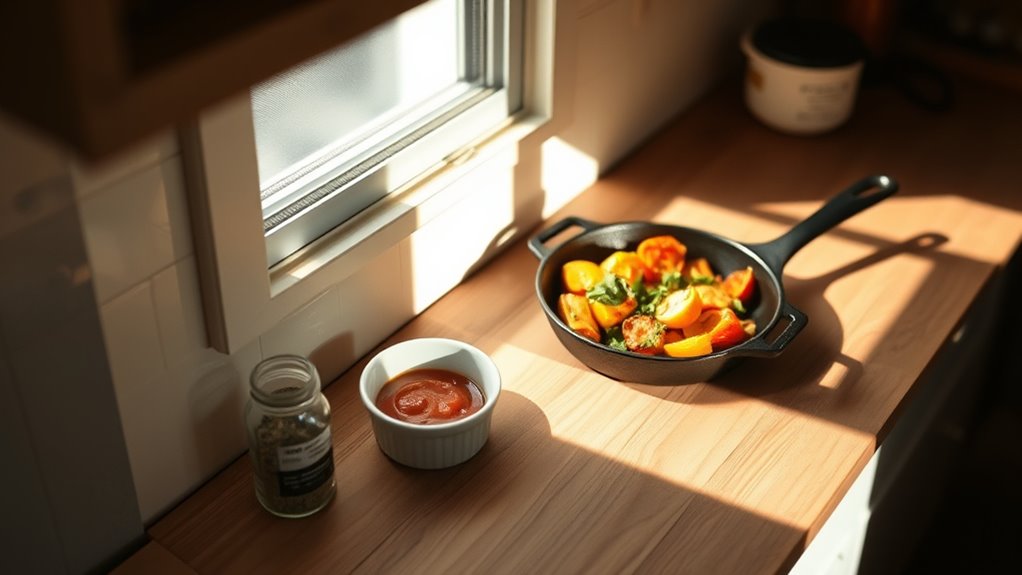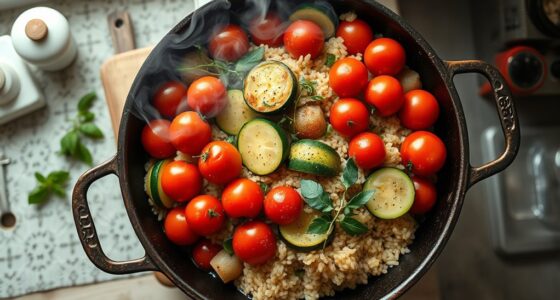In a tiny home, focus on small-batch recipes like single-serving casseroles, stir-fries, and one-pan meals to save space and reduce clutter. Plan your meals with versatile ingredients such as rice, beans, and pre-chopped vegetables, and prepare ingredients ahead to streamline cooking. Use multi-functional furniture and clever storage solutions like stackable containers and magnetic strips to keep your kitchen organized. Keep your space tidy and efficient—if you keep exploring, you’ll discover even more ways to maximize tiny home cooking.
Key Takeaways
- Focus on single-serving or small-portions like casseroles, stir-fries, and one-pan dishes to save space and reduce leftovers.
- Plan weekly meals with versatile ingredients to minimize clutter and streamline ingredient management.
- Use multi-functional furniture and compact storage solutions like stackable containers and magnetic strips to maximize tiny home space.
- Prepare ingredients in advance and utilize space-saving utensils to simplify cooking and maintain an organized kitchen.
- Choose recipes that deliver satisfying small portions without excess ingredients or equipment, ensuring a clutter-free cooking experience.

Living in a tiny home means making the most of limited space, especially when it comes to cooking. You need to be strategic about how you approach your meal prep tips and storage solutions to keep your kitchen functional and clutter-free. Small-batch cooking is your best friend here, allowing you to prepare flavorful meals without overwhelming your limited countertop and cabinet space. Focus on recipes that can be made in small portions but still deliver satisfaction, like single-serving casseroles, stir-fries, or one-pan dishes. These recipes save space and reduce leftovers, helping you keep your tiny kitchen organized.
Maximize tiny kitchen space with small-batch recipes and smart storage solutions for clutter-free cooking.
When it comes to meal prep tips, efficiency is key. Plan your meals for the week so you only buy what you need, minimizing clutter and waste. Use versatile ingredients that can be incorporated into multiple dishes, such as rice, beans, or pre-chopped vegetables. Preparing ingredients in advance, like pre-measured spice blends or chopped veggies stored in small containers, streamlines your cooking process and reduces the time you spend in the kitchen. This approach cuts down on the number of utensils and cookware you need, which is essential in small spaces. Keep your prep area clear and organized, with designated spots for frequently used items; this helps you quickly access what you need without creating chaos. Incorporating airless paint sprayers into your home maintenance routine can help you refresh your living space efficiently, especially when updating walls or furniture to keep your tiny home looking its best.
Storage solutions are indispensable in tiny homes. Opt for multi-functional furniture, like ottomans or beds with built-in drawers, to maximize space. Use clear, stackable containers for your prepped ingredients and leftovers, so you can see what you have at a glance. Vertical storage racks or magnetic strips can hold spices, knives, or utensils, freeing up drawer space. Investing in compact, stackable cookware and utensils keeps clutter to a minimum. When storing ingredients, prioritize airtight containers to keep everything fresh and prevent spills. Consider using under-sink or overhead cabinets efficiently, and utilize door-mounted racks for additional storage.
In a tiny home, every inch counts, so your meal prep tips and storage solutions should work hand in hand. Keep your kitchen clutter-free by regularly reassessing what you truly need and use. Stick to simple, small-batch recipes that require fewer ingredients and less equipment, making your cooking experience more enjoyable and manageable. With a little planning, your tiny space can be both functional and cozy, turning even the smallest kitchen into a hub of delicious, home-cooked meals.
Frequently Asked Questions
How Do I Store Small-Batch Ingredients Efficiently?
You should store small-batch ingredients in airtight containers to keep them fresh and prevent spills. Use clear, stackable containers for easy organization and quick access. Bulk storage works well for pantry staples like grains and flour, saving space. Label each container clearly, so you know what’s inside. Keep frequently used ingredients within reach, and rotate stock regularly to avoid waste. This approach maximizes your tiny home’s limited storage efficiently.
What Are Versatile Appliances for Tiny Kitchen Cooking?
You should invest in versatile appliances like multi-use tools and compact gadgets to maximize your tiny kitchen space. A blender that also works as a food processor, a combination air fryer and toaster oven, and a multi-function pressure cooker save space and enhance cooking options. These compact gadgets streamline your cooking process, making meal prep easier and more efficient while ensuring you have the right tool for various recipes without cluttering your small kitchen.
How Can I Prevent Food Waste in Small Portions?
To prevent food waste in small portions, plan your meals carefully and stick to your grocery list during meal prep. Use leftovers creatively for future meals or snacks. Store food properly to extend freshness, and compost scraps when possible to reduce waste. Always portion out meals to avoid excess, and keep an eye on expiration dates. These tips help you minimize waste and make the most of your tiny kitchen space.
Are There Specific Safety Tips for Tiny Kitchen Appliances?
Like a tightrope walker balancing on a thin wire, you must be cautious with tiny kitchen appliances. Always read the safety instructions before use, keep appliances clean, and unplug them when not in use. Be aware of tiny kitchen hazards like overheating or electrical issues. Regularly inspect cords for damage, avoid overloading outlets, and never leave appliances unattended. Following these safety tips guarantees your small space stays safe and efficient.
How Do I Plan Meals for Varied Dietary Needs?
You plan meals for varied dietary needs by starting with meal prep that considers everyone’s restrictions. Make a simple menu, noting specific dietary restrictions like gluten-free or vegetarian options. Use versatile ingredients to accommodate different needs, and prepare separate portions when necessary. Keep a list of preferred foods and allergies to guarantee safe, nutritious meals. This proactive approach helps you efficiently manage dietary restrictions in your tiny home kitchen.
Conclusion
So, next time you whip up a tiny batch meal, remember: your tiny home isn’t just a cozy space, it’s a culinary playground. Who needs a fancy oven when you can master the art of the perfect single-serving dessert? Embrace the chaos of your miniature kitchen—where a single spoonful can turn into an epic feast, and the only thing smaller than your stove is your laundry pile. Bon appétit, tiny chef!









